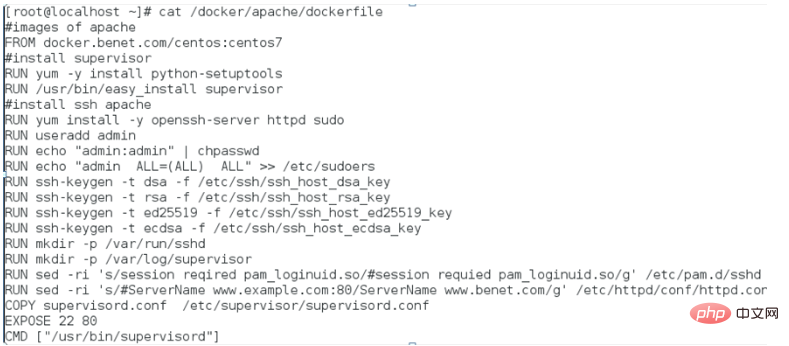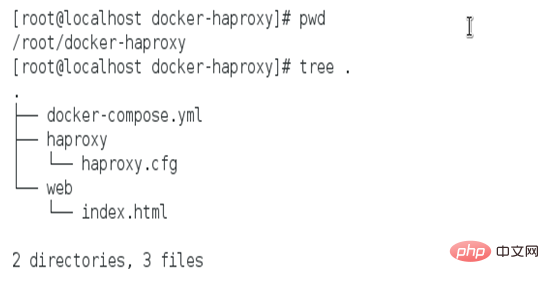What are the docker orchestration tools?

What are the docker orchestration tools?
The docker orchestration tools are:
Two tools used with docker-------Supervisor and Compose. Let’s introduce these two tools and how to use them respectively.
1. Supervisor:
Use the process management tool supervisor to manage multiple processes in the container. Using Supervisor can better control, manage, and restart the processes we want to run. It is a c/s system.
Demonstration: Here we demonstrate how to use ssh and apache services at the same time.
First create a Dockerfile. The content and explanations of each part are as follows.
Create a dockerfile directory

dockerfile file content:

supervisor configuration file content:

The first paragraph supervsord configures the software itself and uses the nodaemon parameter to run. nodaemon=true If true, the supervisord process will run in the foreground. The default is false, which means it runs as a daemon process in the background.
The following 2 paragraphs contain the 2 services we want to control. Each section contains a service directory and the command to start the service
/docker/apache directory content list!

Two: compose: orchestrate and deploy docker-based applications
Usage:
Install Docker-compose, We need to install pip first
Use wget to download: wget https://bootstrap.pypa.io/get-pip.py
Installation:
1.pip install docker -compose
2.ln -s /usr/bin/docker-compose /usr/local/bin/
3. After the installation is complete, you can use the dockercompose command.
We use the compose tool to experiment:
First, use Dockerfile or docker commit to define your application environment
Second, use a docker-compose.yml Define your application and they can be combined into separate containers to form your application.
The third step is to execute docker-composeup -d to start your application. It will pull/run related containers according to the settings of docker-compose.yml.
We use this diagram to represent the working directory structure of this project:

Docker-haproxy is the working directory of a project
Create two subdirectories in this directory, which are the two application directories we need.
Under docker-haproxy we also need a template file docker-compose.yml, which can create isolated containers.
Finally use docker-compose up -d to start the application.
Note: In these configuration files, we need to prepare the CD images to be used
Recommended tutorial: "docker video tutorial"
The above is the detailed content of What are the docker orchestration tools?. For more information, please follow other related articles on the PHP Chinese website!

Hot AI Tools

Undresser.AI Undress
AI-powered app for creating realistic nude photos

AI Clothes Remover
Online AI tool for removing clothes from photos.

Undress AI Tool
Undress images for free

Clothoff.io
AI clothes remover

Video Face Swap
Swap faces in any video effortlessly with our completely free AI face swap tool!

Hot Article

Hot Tools

Notepad++7.3.1
Easy-to-use and free code editor

SublimeText3 Chinese version
Chinese version, very easy to use

Zend Studio 13.0.1
Powerful PHP integrated development environment

Dreamweaver CS6
Visual web development tools

SublimeText3 Mac version
God-level code editing software (SublimeText3)

Hot Topics
 How to exit the container by docker
Apr 15, 2025 pm 12:15 PM
How to exit the container by docker
Apr 15, 2025 pm 12:15 PM
Four ways to exit Docker container: Use Ctrl D in the container terminal Enter exit command in the container terminal Use docker stop <container_name> Command Use docker kill <container_name> command in the host terminal (force exit)
 How to copy files in docker to outside
Apr 15, 2025 pm 12:12 PM
How to copy files in docker to outside
Apr 15, 2025 pm 12:12 PM
Methods for copying files to external hosts in Docker: Use the docker cp command: Execute docker cp [Options] <Container Path> <Host Path>. Using data volumes: Create a directory on the host, and use the -v parameter to mount the directory into the container when creating the container to achieve bidirectional file synchronization.
 How to restart docker
Apr 15, 2025 pm 12:06 PM
How to restart docker
Apr 15, 2025 pm 12:06 PM
How to restart the Docker container: get the container ID (docker ps); stop the container (docker stop <container_id>); start the container (docker start <container_id>); verify that the restart is successful (docker ps). Other methods: Docker Compose (docker-compose restart) or Docker API (see Docker documentation).
 How to check the name of the docker container
Apr 15, 2025 pm 12:21 PM
How to check the name of the docker container
Apr 15, 2025 pm 12:21 PM
You can query the Docker container name by following the steps: List all containers (docker ps). Filter the container list (using the grep command). Gets the container name (located in the "NAMES" column).
 How to start mysql by docker
Apr 15, 2025 pm 12:09 PM
How to start mysql by docker
Apr 15, 2025 pm 12:09 PM
The process of starting MySQL in Docker consists of the following steps: Pull the MySQL image to create and start the container, set the root user password, and map the port verification connection Create the database and the user grants all permissions to the database
 How to start containers by docker
Apr 15, 2025 pm 12:27 PM
How to start containers by docker
Apr 15, 2025 pm 12:27 PM
Docker container startup steps: Pull the container image: Run "docker pull [mirror name]". Create a container: Use "docker create [options] [mirror name] [commands and parameters]". Start the container: Execute "docker start [Container name or ID]". Check container status: Verify that the container is running with "docker ps".
 How to update the image of docker
Apr 15, 2025 pm 12:03 PM
How to update the image of docker
Apr 15, 2025 pm 12:03 PM
The steps to update a Docker image are as follows: Pull the latest image tag New image Delete the old image for a specific tag (optional) Restart the container (if needed)
 Docker Volumes: Managing Persistent Data in Containers
Apr 04, 2025 am 12:19 AM
Docker Volumes: Managing Persistent Data in Containers
Apr 04, 2025 am 12:19 AM
DockerVolumes ensures that data remains safe when containers are restarted, deleted, or migrated. 1. Create Volume: dockervolumecreatemydata. 2. Run the container and mount Volume: dockerrun-it-vmydata:/app/dataubuntubash. 3. Advanced usage includes data sharing and backup.






